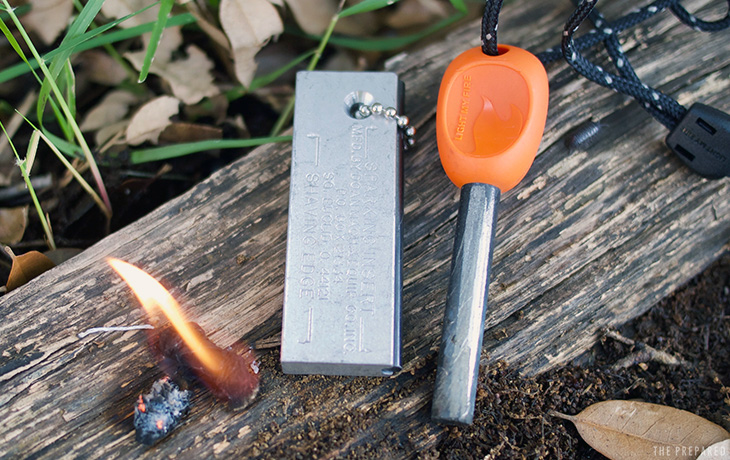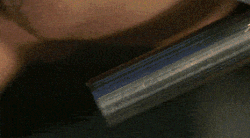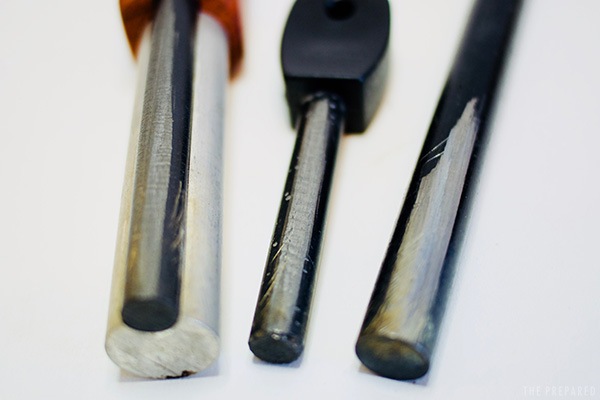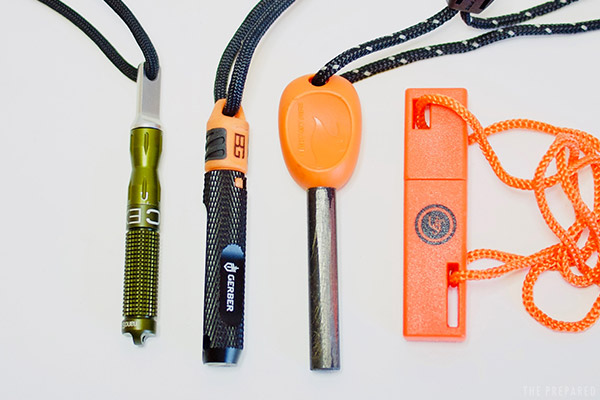The fire steel is an ancient design that operates on a simple principle: you move a hard striker rapidly across a piece of an iron alloy (where the name “ferro” comes from), and the resulting friction removes some of the metal in the form of sparks that can catch tinder on fire. If you’ve ever flicked a BIC lighter, then you’ve used a fire steel — it lights butane (instead of physical tinder) using the same basic sparking mechanism that makes a fire steel work.
A fire piston is often thrown into the same bucket as a ferro rod. But the designs are quite different, and we find that most fire pistons aren’t good enough for most preppers because they have too many moving pieces and parts you need to have on hand.
Why fire steel is great for preppers — even if you rely on a survival lighter or waterproof matches as your primary method:
- Good for tens of thousands of lights
- Simple and extremely reliable, with no moving parts that can fail
- You can buy ferro rods in a range of sizes, from “I’ll never run out of fire” to small and lightweight enough for a keychain or bracelet
- Fire steel works quickly and doesn’t depend on external factors like sunlight availability
- Fire steels work well in combination with other types of fire starting aids, like fatwood, tinder tabs, char cloths, and (especially) magnesium shavings
- Although it takes practice, proper fire steel technique is easy enough that it passes the 10-year-old-child test
- Making fire by hand (like spinning a stick) is a lot more difficult than you expect, so having a tool that doesn’t rely on caveman techniques is a big help
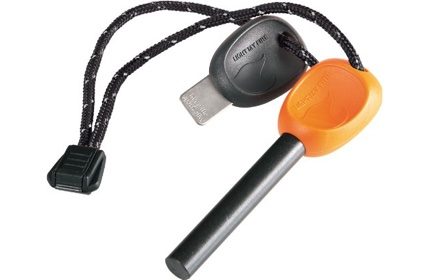
Review winner:
Light My Fire Swedish Firesteel Army
The best ferro rod for preppers is the tried-and-true Swedish Firesteel Army from Light My Fire. This is one of those relatively unusual situations where the product most commonly recommended by random people around the internet also happens to be the actual best choice when tested against the competition.
These premium, European-made steels are popular with preppers and survivalists for their hardness, durability, and ease of use. The LMF easily beat the other 20 popular contenders we compared it to when testing how easy it is for average people (including our young children) to consistently create a high spark volume. The amount of pressure needed to throw sparks felt natural. The second generation of the Swedish Firesteel pairs the original rod with a tweaked handle design and a striker that’s upgraded with better ergonomics and an integrated whistle. LMF offers the Army and Scout versions, which are basically just different sizes, and we recommend the Army over the smaller Scout because the extra size makes it easier to use.
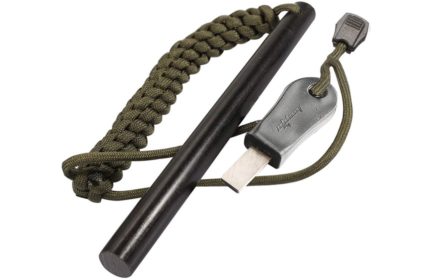
Most fires per dollar:
Bayite Survival 6"
Bigger ferro rods are easier to use and tend to offer more value for the dollar, although they’re bulkier and less portable. If you’re comfortable with the stepped-up size and just want the best deal going, then the Bayite Survival 6” is our top choice. This Chinese-made rod isn’t as hard as the LMF, but it works quite well and is one of the less expensive rods by total volume. It also comes with a high-quality striker and a decent amount of braided paracord.
If we wanted to stock up on bulk ferro rods for an emergency, we’d just buy a bunch of the bare Bayite rods with no lanyard or striker. You can get the 6” rod without cordage and striker for around $10, or a pair of 5” rods for a few dollars less per rod — these are far and away the best value in this whole guide.
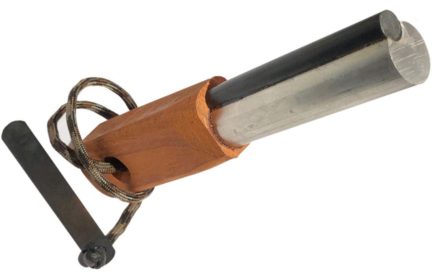
Tinder and ferro combo:
Fire-Fast Trekker
One of the most popular ways to use a ferro rod is to load your tinder pile with fine magnesium shavings. These shavings can turbo-charge your firemaking by catching a spark from your steel and flaring up with a white-hot flame that kicks your tinder right off. Magnesium is so lightweight, inexpensive, and effective that there’s almost no reason not to keep a small bar or block of it in your kit.
The best ferro and magnesium combination fire starter is the Fire-Fast Trekker, which boasts the only ferro rod that performed as well as the LMF in our testing. This is a great value for the money, since not only do you get a top-quality steel and a generous amount of magnesium, but the wooden handle can be shaved to create emergency tinder. The only downsides are bulk and price, but if you’ve got the space (e.g. for your home supplies) and the money for it, definitely get one.
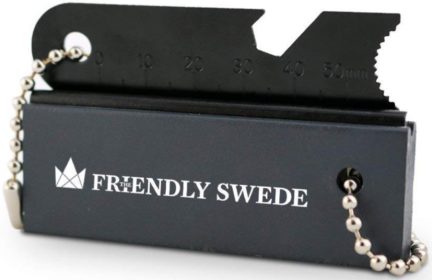
Friendly Swede Magnesium Flint 3-Pack
We don’t have any recommendations for ultra-compact or keychain rods, because none of these performed well enough for the price. Smaller rods are dramatically more expensive by total amount of ferrocerium metal volume (often a 10X jump in price), and are noticeably harder to use. So we do not recommend getting any rods smaller than the LMF.
While still being large enough to be useful, the best compact ferro-magnesium combo bar is the Friendly Swede Magnesium Flint Fire Starter 3-Pack. All of the magnesium in the small ferro-magnesium combo bars we tested performed the same, and this three-pack is the cheapest of the lot, making it a great deal. So toss these in your pack or your glove box, and you’ve got a fantastic fire-starting tool that stores easily and lasts for years of regular use.
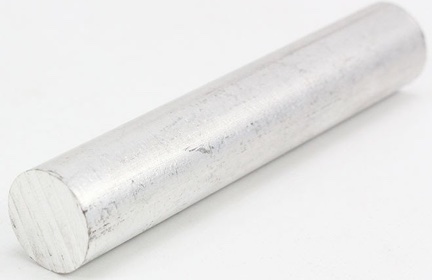
F-ber Magnesium Rod 5-Pack
We tested a number of standalone magnesium bars for firecraft, and they all seemed to work equally as well. The F-ber Magnesium Rod 5-Pack is the best for preppers, though, because it’s the cheapest selection on the list by volume. These are light enough that they add almost no weight to your pack, making them a perfect bug-out companion.
Warning: When purchasing magnesium for firecraft, get the bricks or the rods. Do not buy the bags of magnesium shavings, for these reasons:
- Instead of a sturdy rod or bar, you have a plastic sack of shavings to deal with.
- The shavings will oxidize quicker since more parts are exposed to air.
- Some users report that their magnesium shavings won’t light. This may be user error, or it may be junk mixed in.
Be prepared. Don’t be a victim.
Want more great content and giveaways? Sign up for The Prepared’s free newsletter and get the best prepping content straight to your inbox. 1-2 emails a month, 0% spam.
- How we tested and why you should trust us
- The competition
- Ferro rod basics
- Best firesteel striker (and alternatives already in your kit)
- Tinder: how you catch a spark is more important than how you throw it
- Test results: harder and bigger is better
- Ferro rod and magnesium care and maintenance
- Special combo striker tools
- Review notes
How we tested and why you should trust us
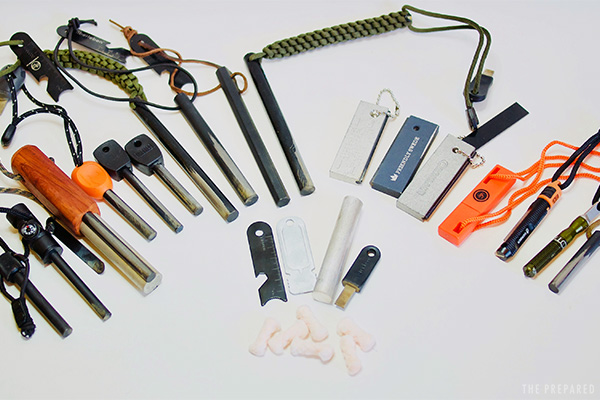
As long-time bushcrafters and preppers with 40 years of combined experience using and reviewing fire starters, we already owned many of these products and had considerable prior research to guide us from the start.
For this review, we spoke with other experts in the community and compiled a list of brands that seemed popular on forums, YouTube, and Amazon. We purchased a representative sample of a little over 20 of the most popular fire starters in addition to the products we already owned.
Because of the difference in performance among the different firesteel sizes, we stuck with steels from roughly three different size categories (measured by diameter):
- Compact (or keychain) steels: 0.25 inches
- Medium-sized: 0.31-0.38 inches
- Large: roughly 0.5 inches or above.
We made the simplifying assumption that all the different firesteels from the same brand have the about same composition and properties. This may not always be true, though, since brands may source different-sized rods from different factories with different quality control levels. But we can’t buy everything, so to the extent that different rods from the same company tend to come from the same source and have similar characteristics, our testing should be representative.
We tested all the products over the course of three days by lighting TinderQuik tabs, along with a few other materials like toilet paper and some leaves, in a controlled environment.
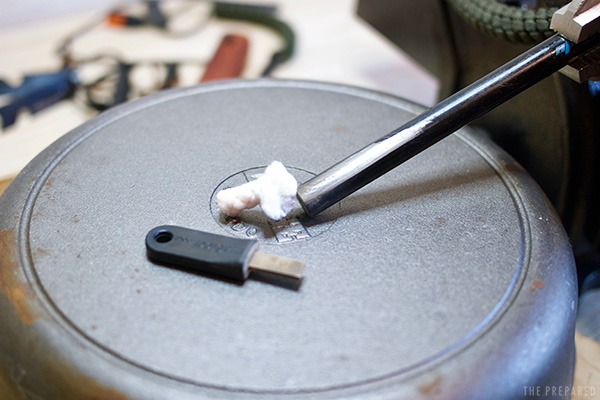
The test setup involved placing the rod in a vice, with the end positioned right in the frayed end of a tinder tab, and striking the rod with a standard striker that I used for all the tests plus any striker that the rod came with. The standard striker we used for each rod was a plastic-handled one from FireSteel.com.
I started out trying to start the TinderQuik tabs without fraying an end, just to simulate slightly more challenging conditions (they light right up if you fray them), but the inconsistency in the tightness of the weave from tab to tab changed their characteristics, so I went to just fraying the end of each tab used in the tests.
The competition
We bought and tested over 40 of these products. See bottom of the review for testing notes on the top contenders.
Ferro rod basics
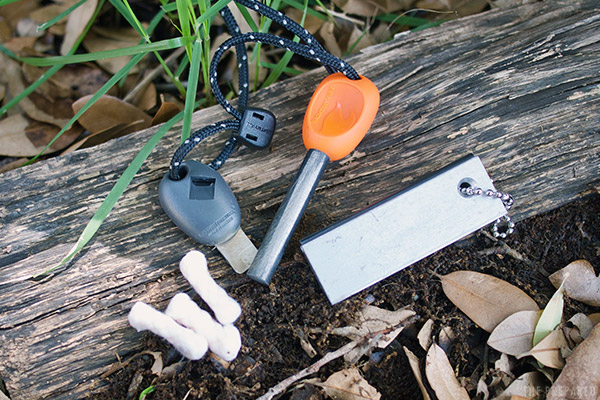
Beginning bushcrafters are obsessed with finding “the best firesteel” or “best ferro rod,” and it definitely is important to get a high-quality rod. But the rod itself is just one part of a three-part firemaking system:
- Ferro rod: a source of sparks and molten metal
- Striker: the tool used to scrape sparks from the rod
- Tinder: a specially prepared bit of flammable material ignited by the temporary sparks from the rod and striker
As you’re shopping for the firesteel part of this three-part setup, you’ll run across three common terms that are used in a really confusing manner:
- Ferro rod: Could be anything from a very hard mix of iron and cerium to a fairly soft blend of iron, cerium, and magnesium.
- Mischmetal rod: Technically the same as a “ferro rod,” but in some circles it refers more narrowly to rods on the softer end of the spectrum.
- Magnesium rod: Same definition as “mischmetal rod,” but even more likely to be a softer, magnesium-heavy blend.
Properly speaking, a ferrocerium rod is primarily a mix of iron (the “ferro” part of the name) and cerium, with a few other metals often included in smaller amounts. Because ferro rods are a mix of different metal types, they’re technically a subtype of the larger family of “mischmetal” rods — “mischmetal” being from the German word for “mixed metal.” So “mischmetal rod” and “ferro rod” are usually just two words for the same thing… but not always.
In many bushcraft and prepper circles, “mischmetal” is used in a narrower sense to refer to rods that add a significant amount of magnesium to the standard ferrocerium mix. These softer, magnesium-infused rods throw a larger shower of sparks when struck, with large globs of molten magnesium flying off and striking the tinder.
Unfortunately, the magnesium-heavy rods are sometimes marketed as “magnesium rods,” which is confusing because preppers can and do buy rods of pure magnesium for tinder. Even worse is that it’s not always clear that a specific “magnesium rod” has much magnesium in it — it may have less than a product marketed as regular “ferro rod”!
Finally, with some of the very soft ferro/magnesium rods, some users will treat the rod itself like a block of pure magnesium, and slowly scrape shavings off it before lighting those shavings by striking the rod quickly. So the line between “magnesium rod” and “ferro rod” is even further blurred.
Best firesteel striker (and alternatives already in your kit)
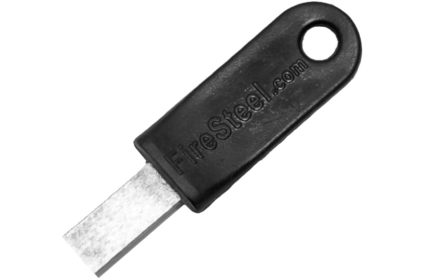
Nice add-on:
FireSteel.com Super Scraper
One of the major factors for ferro rod success is the quality of your striker. The best striker we tested is the $3 Firesteel.com Super Scraper, but all the plastic-handled strikers of this basic pattern seem to work almost equally well. So if you get a rod that comes with this type of striker (like the Bayite Survival 6”), there’s no need to replace it.
A striker works by using friction and speed to throw a spark. If you don’t have enough of either of those two factors, then you won’t get a spark. Conversely, more friction and speed means more sparks, although if you go too fast you’ll lessen the friction to the point that the increased speed is counterproductive.
The amount of friction a striker achieves is proportional to how deeply it bites into the rod’s material as it moves across. You can increase friction by applying more pressure to the striker as you scrape it, or you can sharpen the striker so that it needs less friction to bite into the rod. A sharp striker can throw sparks on a hard steel like the LMF using very little pressure.
It’s important that the striker’s material be as hard as possible, because if it isn’t then it will get deformed and dulled as it scrapes the rod. A dull striker — which means less friction — can still throw sparks if you use enough pressure, but it’s difficult.
Longer strikers can be easier to use than shorter strikers, because of the speed factor and the way the striker acts as a lever when you “flick” it with your wrist. If you’re holding one end of a long striker and you move it a little bit in an arc, the far end of it will move rapidly in relation to the rod. So a very long striker, like the spine of a field knife or back of a Leatherman saw blade, can move faster across the rod and bite deeper into it thanks to the magic of leverage and the power of a good, firm grip.
Conversely, very tiny strikers can be a pain to use, because all of the speed and friction-producing leverage have to come directly from your hand and wrist. It’s a lot harder to move your whole hand back and forth quickly across a firesteel than it is to flick a long striker across it. At the very least, the striker has to be big enough that you can get enough grip on it to apply the right amount of pressure.
In addition to the nicer plastic-handled strikers like the FireSteel.com one we recommend, there are a two other basic striker types that come with many firesteel products:
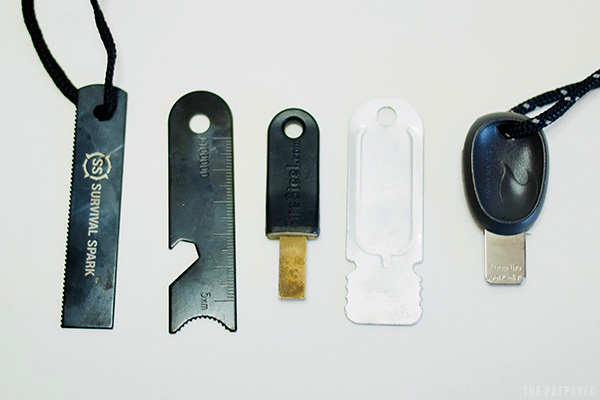
The common Y-shaped striker, which has a small ruler and some other features, came with a few of the products we purchased. You’re supposed to use these strikers by inserting rod into the half-moon-shaped notch at the very end. That notch has ridges that are supposed to bite into the firesteel, but really there’s not much difference between using that notch and using any of the other sides of the steel.
These strikers are all identical and probably come from the same company, but their performance is wildly inconsistent from unit to unit. (It’s almost like the “Y” stands for Your Mileage May Vary.)
The difference in performance has to do with the fact that these strikers are made of stamped metal, and in some cases the stamping process leaves a small “wire edge” on them. This wire edge is where a bit of metal is folded over and makes a sharp, raised ridge on one side of the tool. This wire edge is fragile, and in many cases does not extend the whole length of the striker’s perimeter. If there is no wire edge, then the striker barely works at all, and if there is one then it works for as long as the edge holds up (i.e. not long).
The common saw blade striker pictured above is a bit of hacksaw blade coated in paint, and it’s the least terrible of the cheap-o strikers you get with some of these products. Unlike with the Y striker, we have yet to run across one of these that only barely works — they all throw a decent spark, especially with enough pressure.
The most popular firesteel striker is probably the spine of a good survival field knife. Many knife manufacturers put sharp angles on the spine explicitly for this type of use. But high-carbon blades that are coated to prevent rust will only throw a spark if you remove enough of that protective coating to get friction on the rod. This exposes the blade to marring and corrosion, so be careful.
Another option preferred by one of our experts is to use the serrations at the base of the edge of a field knife with a partially serrated edge. These serrations are often round and will fit some types of firesteels almost perfectly, and the serration nearest the handle is never actually used so if you dull the edge there it doesn’t matter.
Many experienced bush crafters use the back of the saw on a multitool. This worked extremely well in our testing, and we recommend this approach if you don’t get a dedicated striker and the spine of your knife isn’t suitable.
A file, like the one on your multitool, makes a very effective striker, but it rips off too much material and shortens the lifespan of your rod.
Tinder: how you catch a spark is more important than how you throw it
The number one factor affecting the performance of any given ferro rod is the quality of your tinder pile. With a high-quality, dry tinder pile, just about any rod on the market can kick a flame right off. But a damp or poorly made tinder pile can be showered with molten magnesium sparks and yield nothing.
Tinder is so important that we recommend adding some to your fire preps.
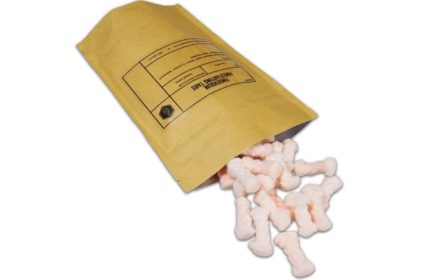
TinderQuik tabs
The $13 TinderQuik tabs are very popular with survivalists, soldiers, and bushcrafters, and they performed amazingly well in all of our testing. We tested the firesteels on toilet paper, paper towels, dry leaves, and a few other tinder types, and the TinderQuik tabs were by far the easiest way to get a sustainable flame going with minimal effort.
Note: We noticed in our testing that some TinderQuick tabs are compressed too tightly in the factory. That means there’s less well-oxygenated material to catch the sparks and ignite, to the point some tabs were impossible to light without fraying the ends first.
If you don’t want to pay for TinderQuiks are are willing to put up with a little bit of mess an effort, you can also cover cotton balls or wads of dryer lint in petroleum jelly to make very effective tinder tabs:
As for natural tinder found in the wild, the main rule for firesteels is the finer the fibers in it, the better. If you’re going to catch a flame from a tiny spark, you need a tiny fiber that will light up and then light its neighbors.
One of our experts takes the tops of tall, dried grass and crushes it in his hand by rubbing it until it’s broken down into a fine, rough nest. Others use cattails or wood shavings. But any natural material that can be rendered fibrous, fine, and dry will work.
Test results: harder and bigger is better
European-made rods are typically of the harder variety, and are much more expensive than the softer rods, which are often made in China.
Our testing showed that the harder rods with less magnesium throw a smaller shower of sparks and last longer. Conversely, the softer, magnesium-heavy rods throw larger spark showers and have a shorter lifespan, since you’re scraping off bigger chunks of burning metal with each trike.
So which is better? The choice comes down partly to personal preference. But we do find there’s a prepper consensus for the harder, European-made rods. The argument is that spark showers from the harder rods tend to be a little more focused, and you don’t need all that molten magnesium flying around to get your tinder lit if you take some time to practice.
The FireFast Trekker and LMF on the left in the picture have a striped, ridged texture to them, while the Bayite on the right is flatter. The softer the rod, the flatter it is when you scrape it, while the harder rods wear with the ridged pattern seen here.
We definitely found the harder rods easier and more comfortable to use. In fact, we also gave the entire batch of test rods to a group of children, ages 5 to 10, and they all expressed a significant preference for the harder firesteels. The two LMF steels and the FireFast Trekker were kid favorites, because they could get a nice shower of sparks with very little pressure.
The softest and smallest firesteels, in contrast, totally defeated the kids — their small hands just couldn’t get enough pressure and speed on these to do anything more than shave chunks of metal off without a spark.
Size matters
Ferro rod performance is also related to size, which makes sense because you can scrape more material off a larger rod with each stroke.
All of the small steels we tested were relatively soft when compared to the LMF. A few of them, like the Exotac nanoSTRIKER, were very soft, and this combination of smallness and softness made it difficult to get enough pressure to throw a good spark.
The Gerber Bear Grylls was a harder compact steel, but it was still much less pleasant to use than the LMF.
Given the cost of the different compact / keychain firesteels, it’s difficult to see why you’d pick one over the LMF Army. It’s nice that the nanoSTRIKER, UST Sparkforce, and Gerber Bear Grylls all come with a built-in striker and protective enclosure, but it’s better to just get more (and harder) ferrocerium for the money than that extra stuff. Besides, as the picture above shows, you’re not actually saving that much space with the smaller steels (first two on left vs. the LMF with orange handle).
Ferro rod and magnesium care and maintenance
Both ferro rods and magnesium blocks will oxidize when exposed to the elements, so they both should be kept coated if possible.
Ferro rods in particular will corrode quickly if exposed to salt water, and this corrosion can be accidentally accelerated if acid is present in the mix and another metal is in contact with the rod. This combination of two metals, salt, and acid will form a battery that causes deep pitting on the rod.
Almost all ferro rods come with a protective black lacquer on them, but you’ll scrape that off as you use it. Many preppers re-coat the rods with nail polish after use, because it’s hard and durable and will keep moisture out. A few use oil.
Whatever you do, the main thing is that you keep your rod away from salt, moisture, and acid.
Salt will wreck magnesium, too, so you’ll want to keep any pure magnesium blocks or bars coated, as well. The better magnesium blocks actually come with a coating already on them.
If you don’t coat your magnesium, it will develop a gray oxidation layer that offers some minor protection from further corrosion. But as with the ferro rod, go ahead and put some clear nail polish or other coating on it, and be sure to keep it dry.
Special combo striker tools
There are a handful of combination striker/firesteel tools that are meant for one-handed use, the most popular of which is the $13 UST BlastMatch.
These combo tools are convenient and can create a large spark with little effort and no skill. So they can have a place in your preps as backups for children or others in your group who haven’t practiced even the most basic ferro skills.
But we don’t recommend these for general use because it’s hard to improve on a simple, high-quality ferro rod and a striker. When you start adding springs and other breakable wear parts to an ultra-simple system like the firesteel, you increase the possibility for failure. So it’s best to save your money and keep it simple.
Review notes for the top contenders
Light My Fire Swedish Firesteel Army 1.0: $17. This is the classic Swedish firesteel that many preppers already have. There’s no substantial difference between this steel and the v2.0 version, so if you already have one of these then you shouldn’t feel the need to “upgrade” to the latest.
Light My Fire Swedish Firesteel Army 2.0: $18. Our testing indicates that this is the exact same rod as the classic LMF, with the same performance and size. The striker is pretty good, and the built-in whistle is loud. The latest BIO version for $20 is the same rod as the 2.0 version but with a handle built out of biobased plastic. In all, a great package, but relatively expensive by price/volume. Still, it’s worth it.
Bayite Survival 6”: $15. This is a Chinese-made rod — it says so on the packaging. It feels noticeably harder than many of the other non-Euro rods in this roundup, and it’s one of the cheapest options by volume. The striker that comes with it is very good, and of course you get a nice length of paracord. It’s 2mm thicker and a little harder than the Survival Hax rod, which looks similar and has the same paracord lanyard. Survival Hax 6”: It looks just like the Bayite but isn’t. Comes with a small metal capsule that can hold tinder, and a lanyard clasp that acts as a whistle. Also has a striker, but it’s the standard “Y” striker all of these have so quality will vary. It’s a good package, but for the money you’re better off with the Bayite. The tinder capsule and whistle don’t seem worth the 25% boost in price.
Coghlan’s Flint Striker: $5. This has a lot of fans, mainly because it’s so cheap. It’s 1/3rd of the price of the LMF, but it’s fairly soft. If you’re looking for a firesteel with a lot of magnesium that you can easily scrape for shavings before sparking, or if you just want the rock-bottom cheapest option on the menu, then this works. But by volume the Bayite is cheaper, and it’s better.
UST Sparkforce: $7. This is probably the best “gadget”-style striker we tested, just in terms of ability to throw a spark. Its plastic body is not nearly as Gucci as the knurled aluminum exoTAC, but its medium hardness and mid-range price/volume ratio make a solid choice. The striker that’s built-in is not great, so if I got this I’d plan on striking it with something else. If I could take the rod out of this and put it in the exoTAC nanoStriker, it would be killer.
Uberleben Kräftig 5”: $22. Not a bad rod, but it’s not great, especially for the money. The Bayite Survival 6” is longer, harder, and just better than this, despite being substantially less money. Plus, the Bayite comes with free paracord and a great striker. The Kraftig’s striker is the standard Y-shaped striker.
Überleben Hexa: $32. This really doesn’t outperform a rounded rod of the same diameter, as promised, despite the added cost. It’s too much money for too little firesteel, and the shape is a gimmick. Avoid.
Ralix SurvivalSPARK: $8. A little longer than the Coglan’s, and maybe just a little harder. Packaged with a decent saw-style scraper. Also has a built-in compass and whistle, which are gimmicks, but the whistle at least gives you plenty of handle. If I could only have this or the Coglan’s, I’d rather have this, but given that this is inching up on 2X the price of the Coglan’s I’d rather have two of the latter than one of these if money were the overriding factor.
SurvivalFrog Magnesium Firestarter: $9. Exact same product as the Ralix SurvivalSPARK, just a different brand name.
Firesteel Armageddon: $17. These are popular recommendations on forums, but this steel did not impress. It’s not even close to the LMF in performance, and it’s not all that much cheaper. The striker is fantastic, and is what I used on all the tests. But the rod itself is one of the softest in the batch, and we just didn’t get all the love for these. There is no question that the LMF beats the pants off of this.
Hedgehog Fire Starter: $40. We already had and loved the Hedgehog in our personal collection, until testing it directly against the LMF and realizing it just doesn’t stack up. It’s a great rod, and I absolutely adore the design — the flexible little lanyard and the knurled grip. But the LMF is harder and better. You’re high if you spend $40 on this instead of getting two LMFs for that price.
